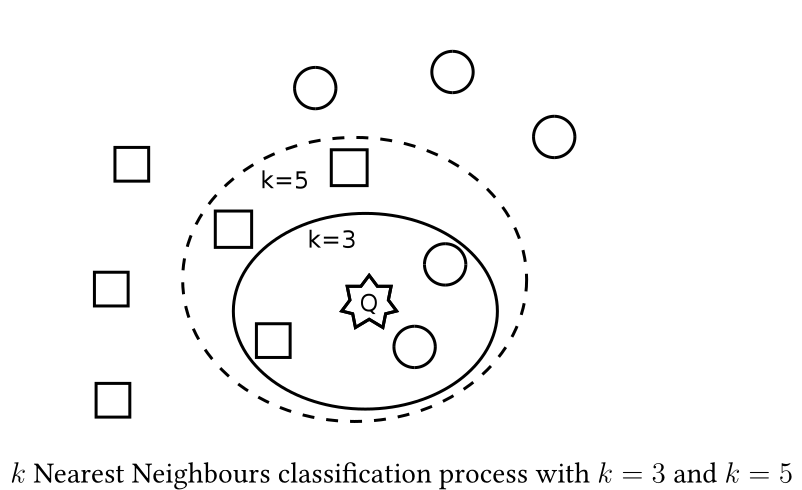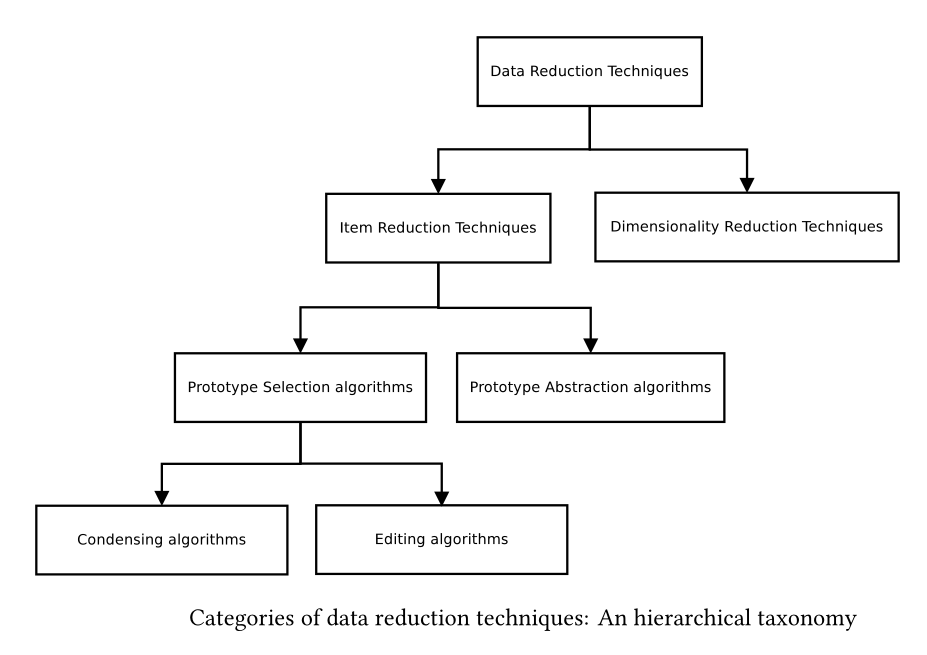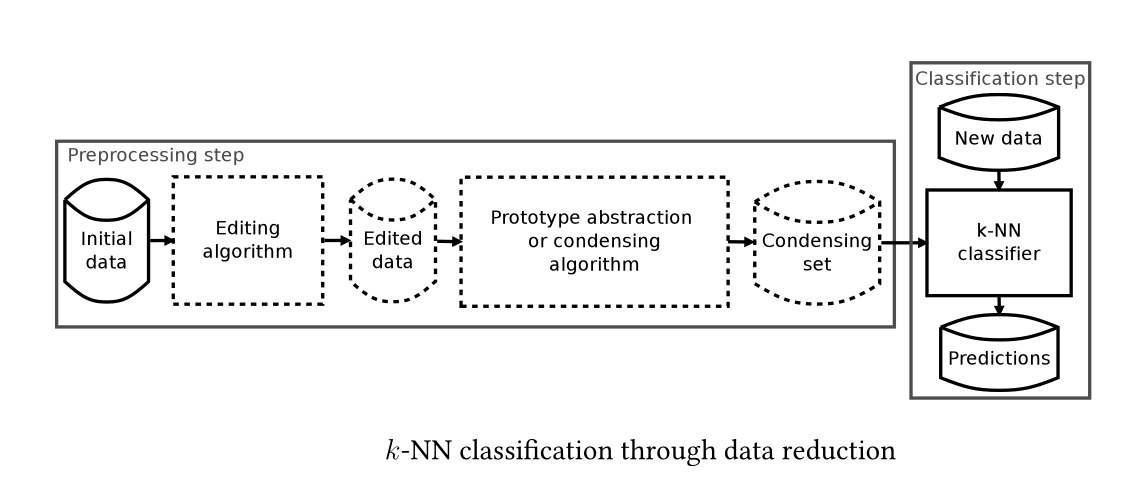k-Nearest Neighbour Classifier & Data Reduction Techniques¶
WebDR: A Web workbence for Data Reduction
Scikit-learn is a free software machine learning library for Python.
Table of contents¶
k-NN Classifier ¶
- Extensively used and effective lazy classifier
- Easy to be implemented
- It has many applications
- It works by searching the database for the k nearest items to the unclassified item
- The k nearest items determine the class where the new item belongs to
- The "closeness" is defined by a distance metric

Weaknesses of k-NN classifier¶
- High computational cost: k-NN classifier needs to compute all distances between an unclassified item and the training data
- High storage requirements: The training database must be always available
- Noise sensitive algorithm: Noise and mislabeled data, as well as outliers and overlaps between regions of classes affect classification accuracy
Example¶
Data¶
In [27]:
import matplotlib.pyplot as plt
from math import sqrt
points = [
[1,1,"Red"],
[1,2,"Red"],
[2,1,"Black"],
[3,4,"Black"],
[4,6,"Black"]
]
plt.title("Points")
plt.xlabel("x")
plt.ylabel("y")
for point in points:
plt.plot(point[1],point[0], "o", color=point[2])
Function for euclidean distance¶
$d_{ij} = \sqrt{ \sum_{i=1}^{p} (X_{ik} - X_{jk})^2 }$
In [28]:
def euc_dis(point1, point2):
return sqrt( (point1[0]-point2[0])**2 + (point1[1]-point2[1])**2 )
Function for k-NN Classification¶
In [40]:
def knn(point, points, k):
result = 0;
distance = []
for i in range(len(points)):
distance.append([euc_dis(point, points[i]), points[i][2]])
distance.sort()
for i in range(k):
if distance[i][1] == "Red":
result += 1
else:
result -= 1
if result >= 0:
return "Red"
else:
return "Black"
Calling the k-NN function¶
In [41]:
print("The point [2,1] is:", knn([2,1], points, 3), " with K=3")
print("The point [2,1] is:", knn([2,1], points, 5), " with K=5")
Data Reduction Techniques ¶

Condensing and Prototype Abstraction (PA) algorithms¶
- They deal with the drawbacks of high computational cost and high storage requirements by building a small representative set (condensing set) of the training data
- Condensing algorithms select and PA algorithms generate prototypes
- The idea is to apply k-NN on this set attempting to achieve as high accuracy as when using the initial training data at much lower cost and storage requirements

Editing algorithms¶
- They aim to improve accuracy rather than achieve high reduction rates
- They remove noisy and mislabeled items and smooth the decision boundaries. Ideally, they build an a set without overlaps between the classes
- The reduction rates of PA and condensing algorithms depend on the level of noise in the training data
- Editing has a double goal: accuracy improvement and effective application of PA and condensing algorithms


Dealing with noise using large k ¶
- In general, the value of k that achieves the highest accuracy is dataset dependent
- Usually, larger k values are appropriate for datasets with noise since they examine larger neighborhoods
- However, large k values fail to clearly define the boundaries between distinct classes
- Determining the best k is a time consuming procedure
- Even the best k may not be optimal. Different k values may be optimal for different areas of the multidimensional space
Editing algorithms (for noise removal) ¶
Edited Nearest Neighbor Rule (or Wilson's editing) ¶
- The first editing algorithm and the basis of all other editing algorithms
- A training item is considered as noise and removed if its class label is different from the majority of its k nearest neighbours
Drawbacks¶
- It is parametric algorithm: k should be adjusted through time-consuming trial-end-error procedures
- High preprocessing cost: ENN-rule needs to compute: $\frac{N \cdot (N-1)}{2}$ distances
In [ ]:
# ENN-rule
All k-NN ¶
- Well-known variation of ENN-rule
- It iteratively executes ENN-rule with different k values
- In this way, it tries to remove even more noisy items
Drawbacks¶
- It is parametric algorithm: kmax should be adjusted through time-consuming trial-end-error procedures
- High preprocessing cost: All k-NN needs to compute: $\frac{N \cdot (N-1)}{2}$ distances
In [45]:
# All k-NN
Multiedit ¶
- It is also based on ENN-rule
- Initially the training set is divided into n random subsets
- It applies ENN-rule (with k=1) over each item of each one subset, but searching for the nearest neighbour in the modn following subset
- The misclassified items are removed
- The whole process is repeated until the last R iterations produce no editing
Drawbacks¶
- It is parametric algorithm: n and R should be adjusted through time-consuming trial-end-error procedures
- It usually has even higher preprocessing cost than ENN-rule and All k-NN
- It may consider non-noisy items as noise. It may eliminate entire classes
- It is based on a random formation of subsets. Repeated applications may build a different edited set from the same training data
In [46]:
# Multiedit
Condensing algorithms (They select prototypes) ¶
Condensing Nearest Neighbor Rule ¶
- CNN-rule is the earliest and a reference Condensing algorithm
- Items that lie in the “internal” data area of a class (i.e., far from class decision boundaries) are useless during the classification process. They can be removed without loss of accuracy
- CNN-rule tries to place into the condensing set only the items that lie in the close-class-border data areas
- CNN-rule tries to keep the close-class-border items as follows:
- Initially, an item of the training set (TS) is moved to the condensing set (CS)
- Then, CNN-rule applies 1-NN rule and classifies the items of TS by scanning the items of CS
- If an item is misclassified, it is moved from TS to CS
- The algorithm continues until there are no moves fromTS to CS during a complete pass of TS (This ensures that the content of TS is correctly classified by the content of CS)
- The remaining content of TS is discarded
- The main idea behind CNN-rule is that if an item is misclassified, it is close to a border area and so it must be placed into the Condensing Set (CS)
- CNN-rule ensures that all removed TS items can be correctly classified by the content of CS
Advantages¶
- Non parametric
Drawbacks¶
- Order dependent
- Memory based
- Non incremental
In [47]:
# CNN-rule
IB2 ¶
- Is a fast one-pass version of CNN-rule
- Like CNN-rule:
- Is non-parametric
- Is order dependent
- Contrary to CNN-rule:
- Does not ensure that all discarded items can be correctly classified by the CS
- Builds its condensing set incrementally (appropriate for dynamic/streaming environments)
- Does not require that all training data reside into the main memory
- Each training item x ∈ T S is classified using the 1-NN classifier on the current Condensing Set (CS)
- If x is classified correctly, it is discarded. Otherwise, x is transferred to CS
Note: New training data segments can update an existing condensing set in a simple manner and without considering the “old” (removed) data that had been used for the construction of CS
In [ ]:
# IB2
Data abstraction (generation) algorithms (They generate prototypes) ¶
The algorithm of Chen and Jozwik ¶
- Chen and Jozwik’s algorithm (CJA) initially retrieves the most distant items, x and y in TS (diameter) and divides TS into two subsets: items that lie closer to x are placed in Sx whereas items that lie closer to y are placed in Sy
- CJA proceeds by selecting to divide subsets that contain items of more than one classes (non-homogeneous subsets). The non- homogeneous subset with the largest diameter is divided first. If all subsets are homogeneous, CJA continues by dividing the homogeneous subsets
- This procedure continues until the number of subsets becomes equal to a user specified value
- For each created subset S, CJA averages the items in S and creates a mean item that is assigned the label of the majority class in S. The mean items created constitute the final condensing set.
- CJA selects the next subset that will be divided by examining its diameter. The idea is that a subset with a large diameter probably contains more training items. Therefore, if this subset is divided first, a higher reduction rate will be achieved.
CJA properties:
- It builds the same CS regardless of the ordering of the data in TS
- It is parametric
- The items that do not belong to the most common class of the subset are not represented in CS
In [ ]:
# CJA
Reduction by Space Partitioning ¶
- CJA is the ancestor of RSP algorithms
- RSP1 computes as many mean items as the number of different classes in each subset (it does not ignore items)
- RSP1 builds larger CS than CJA
- It attempts to improve accuracy since it takes into account all training items
- Similar to CJA, RSP1 uses the subset diameter as the splitting criterion, based on the idea that the subset with the larger diameter may contains more training items, and so, a higher reduction rate could be achieved.
- RSP1 and RSP2 differ on how they select the next subset to be divided
- RSP2 uses as its splitting criterion the highest overlapping degree
- The overlapping degree of a subset is the ratio of the average distance between items belonging to different classes and the average distance between items that belong to the same class.
- RSP3 continues splitting the non-homogeneous sub-sets and terminates when all of them become homogeneous
- It can use either the largest diameter or the highest overlapping degree as spiting criterion
- RSP3 is the only RSP algorithm (CJA included) that automatically determines the size of CS
- like CJA, RSP1 and RSP2, CS built by RSP3 does not depend on the data order in TS
In [48]:
# RSP3
The algorithm:
- It utilizes a simple data structure S to hold the unprocessed subsets
- Initially, the whole TS is an unprocessed subset
- At each repeat-until iteration, RSP3 selects the subset C with the highest splitting criterion value
- If C is homogeneous, the mean item is computed by averaging the items in C and is paced in CS
- Otherwise, like CJA, C is divided into two subsets D1 and D2
- These new subsets are added to S
- The repeat-until loop continues until all subsets are homogeneous
RSP3 properties:
- It generates few prototypes for representing non close class-border areas, and many prototypes for representing close-class-border areas
- The reduction rate achieved by RSP3 highly depends on the level of noise in the data
- Finding the most distant items in each subset implies the computations of all distances between the items of the subset